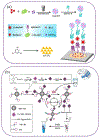Aptamer-functionalized metal-organic frameworks (MOFs) for biosensing
- PMID: 33412430
- PMCID: PMC7855766
- DOI: 10.1016/j.bios.2020.112947
Aptamer-functionalized metal-organic frameworks (MOFs) for biosensing
Abstract
As a class of crystalline porous materials, metal-organic frameworks (MOFs) have attracted increasing attention. Due to the nanoscale framework structure, adjustable pore size, large specific surface area, and good chemical stability, MOFs have been applied widely in many fields such as biosensors, biomedicine, electrocatalysis, energy storage and conversions. Especially when they are combined with aptamer functionalization, MOFs can be utilized to construct high-performance biosensors for numerous applications ranging from medical diagnostics and food safety inspection, to environmental surveillance. Herein, this article reviews recent innovations of aptamer-functionalized MOFs-based biosensors and their bio-applications. We first briefly introduce different functionalization methods of MOFs with aptamers, which provide a foundation for the construction of MOFs-based aptasensors. Then, we comprehensively summarize different types of MOFs-based aptasensors and their applications, in which MOFs serve as either signal probes or signal probe carriers for optical, electrochemical, and photoelectrochemical detection, with an emphasis on the former. Given recent substantial research interests in stimuli-responsive materials and the microfluidic lab-on-a-chip technology, we also present the stimuli-responsive aptamer-functionalized MOFs for sensing, followed by a brief overview on the integration of MOFs on microfluidic devices. Current limitations and prospective trends of MOFs-based biosensors are discussed at the end.
Keywords: Aptamer; Aptasensor; Biosensor; Metal-organic frameworks (MOFs); Microfluidic; Stimuli-responsive.
Copyright © 2020 Elsevier B.V. All rights reserved.
Conflict of interest statement
Declaration of interests
The authors declare that they have no known competing financial interests or personal relationships that could have appeared to influence the work reported in this paper.
Figures









Similar articles
-
Recent Progress in Aptamer-Functionalized Metal-Organic Frameworks-Based Optical and Electrochemical Sensors for Detection of Mycotoxins.Crit Rev Anal Chem. 2024;54(6):1707-1728. doi: 10.1080/10408347.2022.2128634. Epub 2022 Oct 5. Crit Rev Anal Chem. 2024. Retraction in: Crit Rev Anal Chem. 2025;55(4):796. doi: 10.1080/10408347.2024.2437855. PMID: 36197710 Retracted. Review.
-
Aptamer-modified metal organic frameworks for measurement of food contaminants: a review.Mikrochim Acta. 2023 Aug 30;190(9):371. doi: 10.1007/s00604-023-05937-2. Mikrochim Acta. 2023. PMID: 37646854 Review.
-
Metal organic frameworks as advanced functional materials for aptasensor design.Spectrochim Acta A Mol Biomol Spectrosc. 2022 Aug 5;276:121251. doi: 10.1016/j.saa.2022.121251. Epub 2022 Apr 9. Spectrochim Acta A Mol Biomol Spectrosc. 2022. PMID: 35429856 Review.
-
Recent advances in metal-organic framework-based photoelectrochemical and electrochemiluminescence biosensors.Analyst. 2023 May 16;148(10):2200-2213. doi: 10.1039/d3an00222e. Analyst. 2023. PMID: 37009770 Review.
-
Electrochemical Aptasensors Based on Hybrid Metal-Organic Frameworks.Sensors (Basel). 2020 Dec 5;20(23):6963. doi: 10.3390/s20236963. Sensors (Basel). 2020. PMID: 33291498 Free PMC article. Review.
Cited by
-
Antibacterial Vancomycin@ZIF-8 Loaded PVA Nanofiber Membrane for Infected Bone Repair.Int J Mol Sci. 2022 May 18;23(10):5629. doi: 10.3390/ijms23105629. Int J Mol Sci. 2022. PMID: 35628439 Free PMC article.
-
Introduction of Nanomaterials to Biosensors for Exosome Detection: Case Study for Cancer Analysis.Biosensors (Basel). 2022 Aug 17;12(8):648. doi: 10.3390/bios12080648. Biosensors (Basel). 2022. PMID: 36005042 Free PMC article. Review.
-
A nanoplatform-based aptasensor to electrochemically detect epinephrine produced by living cells.Mikrochim Acta. 2023 Aug 4;190(9):343. doi: 10.1007/s00604-023-05902-z. Mikrochim Acta. 2023. PMID: 37540351
-
Microfluidic platforms integrated with nano-sensors for point-of-care bioanalysis.Trends Analyt Chem. 2022 Dec;157:116806. doi: 10.1016/j.trac.2022.116806. Epub 2022 Oct 29. Trends Analyt Chem. 2022. PMID: 37929277 Free PMC article.
-
Preparation of Ag-Metal organic frameworks-loaded Sodium Alginate Hydrogel for the treatment of periodontitis.Sci Rep. 2025 Jan 4;15(1):800. doi: 10.1038/s41598-025-85123-x. Sci Rep. 2025. PMID: 39755826 Free PMC article.
References
-
- Balogh D, Garcia MAA, Albada HB, Willner I, 2015. Angew. Chemie Int. Ed 54, 11652–11656. - PubMed
-
- Bao T, Fu R, Wen W, Zhang X, Wang S, 2020. ACS Appl. Mater. Interfaces 12, 2087–2094. - PubMed
-
- Brown AJ, Brunelli NA, Eum K, Rashidi F, Johnson JR, Koros WJ, Jones CW, Nair S, 2014. Science 345, 72–75. - PubMed
-
- Cao Y, Wang L, Shen C, Wang C, Hu X, Wang G, 2019. Sensors Actuators, B Chem. 283, 487–494.
Publication types
MeSH terms
Substances
Grants and funding
LinkOut - more resources
Full Text Sources
Other Literature Sources
Research Materials
Miscellaneous

